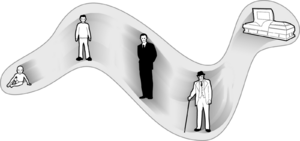Perception of eternalism: Difference between revisions
>Josikins further improvements, still needs alot of work to make this effect sound legitimate |
>Josikins finished proofreading/overhauling for now |
||
| Line 1: | Line 1: | ||
<onlyinclude>[[File:Time is connected.png|thumbnail|300px|The image above represents how a person under the influence of this component would view themselves as an organism. This is often described as being a singular structure which stretches through the physical dimension of time alongside of all other identically behaving structures which the universe as a whole is entirely comprised of.]] | <onlyinclude>[[File:Time is connected.png|thumbnail|300px|The image above represents how a person under the influence of this component would view themselves as an organism. This is often described as being a singular structure which stretches through the physical dimension of time alongside of all other identically behaving structures which the universe as a whole is entirely comprised of.]] | ||
'''Perception of eternalism''' can be described as a | '''Perception of eternalism''' can be described as a major alteration of one's perspective of the fundamental mechanics behind the linear continuity of past, present, and future timelines. During this state of mind one feels as if all points across the timeline of existence are equally "real" and are occurring simultaneously alongside each other. | ||
This sudden change in perspective | This sudden change in perspective starkly contrasts with the standard perception of time in which only the present feels "real", while the past no longer exists and the future is yet to manifest. However, despite this perspective, the directional flow of causality is felt to be maintained, and thusly one feels as if they may only experience life one frame at a time using information which was acquired from "prior" events | ||
A common conclusion that is | A common conclusion that is reached during the experience of this state is that although one's life inevitably will end, it will occur forever within its own timeframe and is therefore perpetual despite not being infinite in its length. | ||
Perception of eternalism is most commonly induced under the influence of heavy dosages of psychedelic tryptamines such as [[psilocin]], [[ayahuasca]], [[DMT]], and [[4-AcO-DMT]]. The effect is commonly accompanied by other [[transpersonal effects]] such as [[unity and interconnectedness]] and [[feelings of interdependent opposites]].</onlyinclude> | |||
===Psychoactive substances=== | ===Psychoactive substances=== | ||
Compounds within our [[psychoactive substance index]] which may cause this effect include: | Compounds within our [[psychoactive substance index]] which may cause this effect include: | ||
Revision as of 20:47, 27 December 2017

Perception of eternalism can be described as a major alteration of one's perspective of the fundamental mechanics behind the linear continuity of past, present, and future timelines. During this state of mind one feels as if all points across the timeline of existence are equally "real" and are occurring simultaneously alongside each other.
This sudden change in perspective starkly contrasts with the standard perception of time in which only the present feels "real", while the past no longer exists and the future is yet to manifest. However, despite this perspective, the directional flow of causality is felt to be maintained, and thusly one feels as if they may only experience life one frame at a time using information which was acquired from "prior" events
A common conclusion that is reached during the experience of this state is that although one's life inevitably will end, it will occur forever within its own timeframe and is therefore perpetual despite not being infinite in its length.
Perception of eternalism is most commonly induced under the influence of heavy dosages of psychedelic tryptamines such as psilocin, ayahuasca, DMT, and 4-AcO-DMT. The effect is commonly accompanied by other transpersonal effects such as unity and interconnectedness and feelings of interdependent opposites.
Psychoactive substances
Compounds within our psychoactive substance index which may cause this effect include: